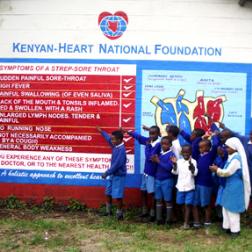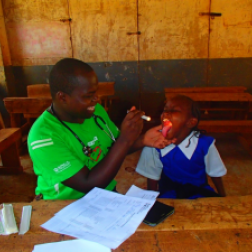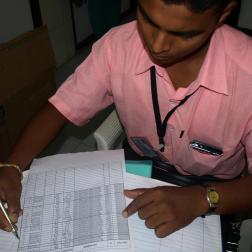Health screening programs are designed to ’discover those among the apparently well who are in fact suffering from the disease’. Screening is a specialised issue in medicine and public health because it involves actively seeking disease in people who would otherwise be considered well. This proactive approach raises unique practical and ethical issues.
WHO have supported auscultation (stethoscope) screening of children for RHD in high risk populations since the 1970's. A WHO supported auscultation screening program began in 1984, and included 1.4 million school children in 16 countries. In 2001 the WHO Expert Committee for ARF and RHD again recommended auscultation screening for high risk populations. This search for heart murmurs represented a large scale attempt to identify children with RHD. However, the advent of echocardiography (echo) has revolutionised screening for RHD, offering risks and benefits.
In 2007, Marijon et al compared the classical approach of auscultation screening with stethoscopes to screening with portable echocardiography. Case detection of asymptomatic RHD was up to ten fold higher with echocardiography than auscultation. Rapid diffusion of portable echocardiography technology was associated with a large number of research activities to quantify the prevalence of RHD. However, without standardized diagnostic criteria comparison of echocardiography screening studies was difficult.
In 2012, Remenyi et al published the World Heart Federation for echocardiographic diagnosis of RHD, applicable to asymptomatic patients aged under 20 years. This global criteria potentiates a new era of robust and reproducible echocardiography screening. The WHF criteria created two categories of ‘definite RHD’ and ‘borderline RHD’ The natural history of borderline disease remains uncertain; a large multicentre trial is needed to understand the effect of secondary prophylaxis on mild valve lesions.
Most large scale echo projects have been conducted to provide baseline descriptive epidemiology and burden of disease data. The information and engagement from echo screening projects has been important for the growing international interest in RHD. However, the clinical application of echo screening for detecting early disease and providing opportunities for intervention remains unclear. The rapid increase in echo screening programs has prompted concern about the ethics and feasibility of screening, given these uncertainties.
Many countries have criteria to establish when population screening is appropriate, and what issues need to be considered. One of the well-known criteria are presented below:
|
Suitability of RHD for echocardiography screening |
|
|
Evidence of a significant burden of disease |
There is strong evidence of a significant burden of disease in low resource settings worldwide. |
|
Condition must have a latent stage |
RHD has an asymptomatic phase, particularly if the first episode of ARF was mild or undiagnosed. Mild valve lesions identifiable only through echocardiography are called ‘subclinical RHD’. The clinical significance and natural history of valve lesions in RHD are poorly understood. |
|
The latent stage must be detectable by simple, accessible and sensitive tests |
Although echocardiography is a relatively non-invasive procedure defining ‘screen positive’ disease has been challenging. There are many small variations of normal heart valves, and it may be difficult to distinguish normal valves from rheumatic heart valves. Early studies of echo screening for RHD used slightly different criteria to define disease, making it difficult to interpret and compare results from around the world. Despite attempts to standardise diagnostic criteria by WHO and large variations in burden of disease were caused by subtle changes in criteria for diagnosis.
In 2012 a group of experts developed a rigorous approach to diagnose subclinical RHD: the World Heart Federation criteria for echocardiographic diagnosis of rheumatic heart disease. These criteria define the morphology (shape) and functional changes of valves affected by RHD.
|
|
The early stage of disease must be treatable with adequate therapy |
Regular secondary prophylaxis prevents ARF recurrences and minimizes progression in valve lesions of RHD. However, delivery of high quality prophylaxis is difficult in many parts of the world.
Undertaking ongoing clinical echo screening for RHD if your program is unable to provide very good secondary prophylaxis to people already on the register is rarely appropriate or ethical.
|
|
Early intervention must improve prognosis |
The natural history of subclinical RHD has not been fully established, and the progression, stability or regression of valve lesions is unclear. |
“We emphasize the importance of having a well-run and effective secondary prophylaxis program in place before embarking on larger-scale screening, and the capacity to upscale this program with newly detected patients.”





